
The origin of the .35 Whelen has long been debated despite the fact that in two of his books, Colonel Whelen named James V. Howe as its developer.
Read more: http://www.gunsandammo.com/ammo/rifle-ammo/the-35-whelen-story/#ixzz5G4PM5kyt
Remington forever legitimized the .35 Whelen when it began loading it in 1988. Eventually, Big Green would offer it in the Model 700 as well as its slide-action and semiautomatic rifles.
Read more: http://www.gunsandammo.com/ammo/rifle-ammo/the-35-whelen-story/#ixzz5G4PH804y
Prior to that, however, the .35 was one of our most popular wildcats. For about as long as it has been around, its origin has been debated. Some are convinced it was James V. Howe who created it, and others argue with equal fervor that it was Col. Townsend Whelen.
Read more: http://www.gunsandammo.com/ammo/rifle-ammo/the-35-whelen-story/#ixzz5G4PC5HiJ
The argument rages on despite the fact that Whelen long ago settled it in two of his books. In the .35 Whelen section of “Why Not Load Your Own?” (1957), he writes, “This cartridge was developed by James V. Howe in 1922 and named for the writer.”
Page 271 of “The Hunting Rifle,” which was published during the early 1940s, reads in part, “In 1922, Mr. James V. Howe and the writer developed the .400 Whelen cartridge. This cartridge was constructed by taking the .30-’06 case before it had been necked at all and necking it down to .40 caliber. About the time we completed development of this cartridge, I went on a long hunting trip in the Northwest, and when I returned, Mr. Howe showed me another cartridge that he had developed. The .30-’06 case was necked to .35 caliber to use existing .35-caliber bullets. Mr. Howe asked my permission to call this cartridge the .35 Whelen, but he alone deserves credit for its development.”

There is little evidence that Col. Townsend Whelen ever hunted with the .35 Whelen.
Whelen was known for his modesty, but he was equally renowned for his painstakingly accurate reporting. Had he been involved in the creation of the cartridge, he would have written so.
I have two different printings of Whelen’s “The Hunting Rifle.” Almost two pages of one are devoted to the .35 Whelen, but in the later printing, the cartridge is hardly mentioned. The earlier book also has a photo of the .35 Whelen alongside a couple of other wildcats: the .276 Dubiel Magnum and the .22-3000 Lovell. That photo is absent in the later book.
As a colonel in the U.S. Army, Whelen was commanding officer of Frankford Arsenal in Philadelphia where James V. Howe was in charge of the machine shop tool room. In addition to his gunsmithing skills, Howe was an accomplished stockmaker.
Read more: http://www.gunsandammo.com/ammo/rifle-ammo/the-35-whelen-story/#ixzz5G4P474Ye
After leaving Frankford in 1923, he got together with Seymour Griffin and formed Griffin & Howe, a shop that became widely known for building fine custom rifles. The partnership did not work out, and after about six months, Howe moved on to Hoffman Arms Company in Cleveland, Ohio, where he stayed for a long time.
Even though Col. Whelen staked no claim to the .35 Whelen, we still owe him partial credit for its existence. During the 1920s, American Leslie Simpson was considered to be an authority on hunting the African continent. Among other things, he, along with novelist Steward Edward White and a couple of others, was said to have taken more than 50 lions during a control shoot lasting three weeks.
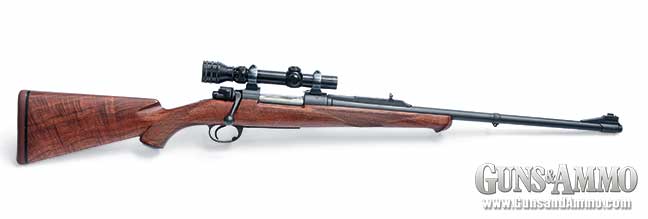
For the past 25 years, this custom rifle on a Whitworth Model 98 Mauser square-bridge action has been the author’s favorite in .35 Whelen. Its 22-inch Apex barrel was made by the late Sam May, and its 1:12-inch twist handles bullets as long as the 310-grain Woodleigh. Butch Searcy did the barreled action, and it was stocked by E.C. Bishop & Son of Warsaw, Missouri.
Simpson and Whelen became friends, and during one of their conversations, Simpson mentioned using the .35 Winchester and finding it lacking. What was needed for taking thin-skinned African game, including lions, was a cartridge of the same caliber but capable of pushing along a 250-grain bullet at 2,500 to 2,600 feet-per-second. Whelen passed the idea on to James Howe, who came up with two cartridges, one of which was the .35 Whelen while he was at Frankford Arsenal.
After moving on to Griffin & Howe, Howe followed up with the .350 G&H Magnum, and it was loaded by Western Cartridge Company.
Whelen had several favorites, but reading his books, I find very little evidence of the .35-caliber cartridge bearing his name being one of them. In fact, I’m not sure he ever actually hunted with it.
The book “Mister Rifleman,” published by Petersen Publishing Company after Whelen’s death in 1961, has a chapter titled “A Rifleman’s Battery.” It’s filled with two-page-spread photos of about 30 rifles owned by Whelen along with comments on each written by him. The only rifle in the group in .35 Whelen was built on a 1903 Springfield action by James Howe in 1922 and originally had a Niedner barrel in .400 Whelen.
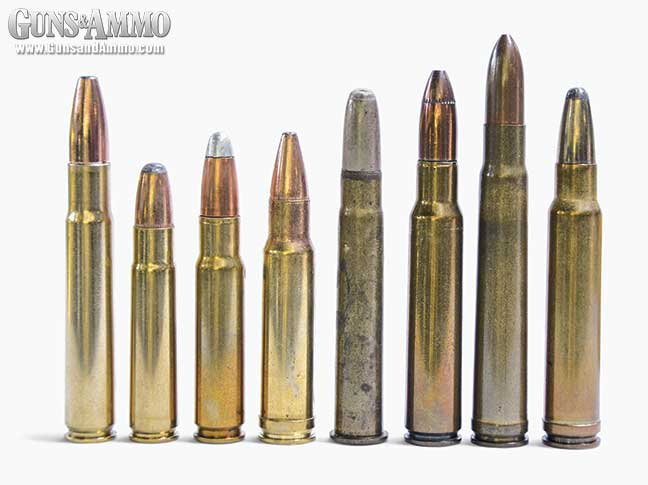
Of the various factory- loaded cartridges of .35 caliber introduced through the years, the .35 Whelen and .35 Remington went on to become the most popular. Left to right: .35 Whelen, .35 Remington, .358 Winchester, .350 Rem. Mag., .35 Winchester, .35 Newton, .350 G&H Mag., .358 Norma Mag.
Due to very little shoulder on its case for headspacing, the .400 was a troublesome cartridge to reload and shoot, yet Whelen did not get around to having the rifle rebarreled to .35 Whelen until around 1950, long after he did most of his hunting. His reloading manual came out seven years later, and he may have needed a rifle in .35 Whelen for developing the loads published in it.
Read more: http://www.gunsandammo.com/ammo/rifle-ammo/the-35-whelen-story/#ixzz5G4OyClVX
Col. Whelen was a practical man, and my guess is that he had very little use for the .35 simply because the game he successfully hunted was easily taken with cartridges of smaller calibers and less recoil. His 40-year Army career began not long after the .30-40 Krag was adopted, and both became favorites in the hunting fields.
He later became equally fond of the .30-’06, 7x57mm Mauser and .257 Roberts, but the .270 Winchester that accounted for his best moose seemed to be his favorite. There were others in his life, both factory and wildcats, with the .243 Winchester and .308 Winchester among the last he wrote up while on the technical staff of Guns & Ammo.
Someone who did hunt a great deal with the .35 Whelen was Elmer Keith. Before using it, he used a custom Springfield in .400 Whelen given to him by James Howe in 1925. Like Whelen, he eventually had his rifle rebarreled to .35 Whelen and used it to take what he described as a record-book brown bear during his first hunt in Alaska in 1937.
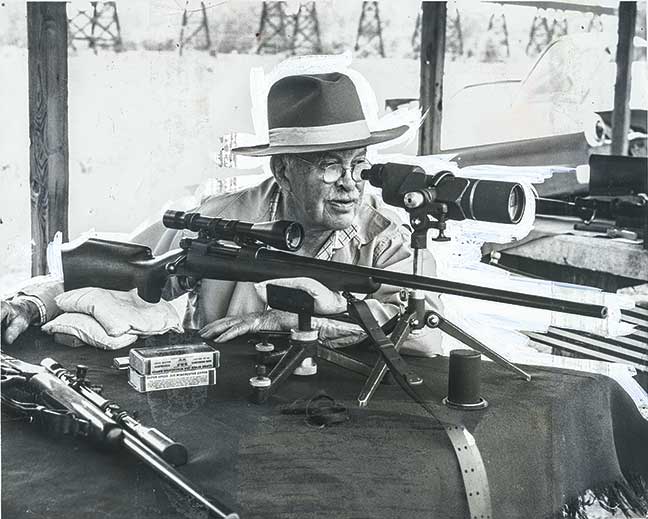
Col. Whelen, dean of American riflemen, shooting his 7mm rifle on assignment for accuracy and trajectory.
Keith took the bruin with a 275-grain bullet made by Western Tool & Copper Co., his favorite for all-around use. He loaded 57 grains of IMR 4064, but that powder in his day was a bit slower in burn rate than today’s version, since 52 grains is now considered maximum with a bullet of that weight. Elmer speculated that the 300-grain roundnose made by Fred Barnes might be a better choice when hunting elk in heavy timber, but I don’t believe he actually got around to trying it.
In notes written about his .35-caliber Griffin & Howe Springfield, Whelen recommended two loads for it with IMR 4350. One was 61 grains behind a 275-grain roundnose bullet made at the time by Joyce Hornady. Velocity was 2,375 fps. The other was 60 grains with the Barnes 300-grain bullet for 2,350 fps.
He must have been using special brass because I am unable to get that much IMR 4350 into factory .35 Whelen cases or those formed from various brands of .30-’06 brass and still have enough space left to seat bullets at the overall cartridge lengths required by the magazines of various bolt-action rifles. The heaviest charges I can squeeze behind 275- and 300-grain bullets are 59 and 53 grains, respectively, for velocities of 2,219 and 2,059 fps.
Reloder 15 has become the powder for .35 Whelen handloads, not only for me but for several other hunters I know who use the cartridge. Clean-burning, it delivers top velocities with all bullet weights, accuracy is usually very good, and it meters through powder measures with minimum charge-to-charge variation.
Read more: http://www.gunsandammo.com/ammo/rifle-ammo/the-35-whelen-story/#ixzz5G4OqymyU
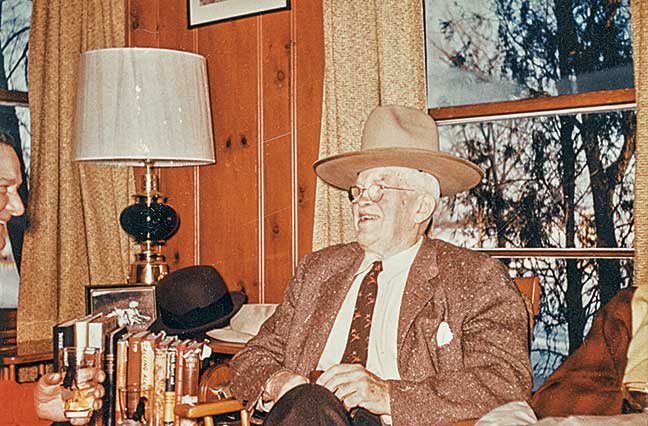
Col. Whelen at Winchester’s Nilo Farms. This photo, taken February 1961, is thought to be his last. He passed away 10 months later, on December 23, 1961, at age 84.
Maximum charges with all bullets weighing from 180 to 210 grains are either 100 percent density or close enough to it. If I were to pick a second favorite, it would be Vihtavuori N-140. Others with similar burn rates include Accurate 2520, Varget, W748 and IMR 4064. Various reloading manuals have data for all of them.
Today’s bullets are much better than in Elmer Keith’s time, and lighter weights than those used by him are capable of taking any game most would want to hunt with the .35 Whelen.
For those who wish to turn back the calendar to the good old days, a few heavyweights are available. Loading the heavier bullets also puts the .35 Whelen on a more equal footing with the 9.3x62mm Mauser. Woodleigh offers a 275-grain Weldcore, and from Swift we have a 280-grain A-Frame. Both are a bit long for the 1:16-inch twist of Remington rifles and usually require 1:14 or quicker.
The Woodleigh 310-grain roundnose is available in both expanding and solid styles; both require a 1:12 twist. I have not tried the 275-grain Lion Load bullet from A-Square, but since it is of roundnose form, it should work in a 1:16 twist. I believe Savage rifles have a 1:12 twist, but I’m not sure about Brownings, Rugers, Winchesters and others.
Unprimed cases are available from Nosler, Hornady, Remington and Norma USA, but necking up .30-’06 cases as in the old days remains an option. A tapered expander button in most .35 Whelen full-length resizing dies makes doing so easy. Applying a light coat of wax-type resizing lube (available from Hornady and Redding) to the mouth of each case makes the job go smoothly. Case loss should be zero if new brass is used.
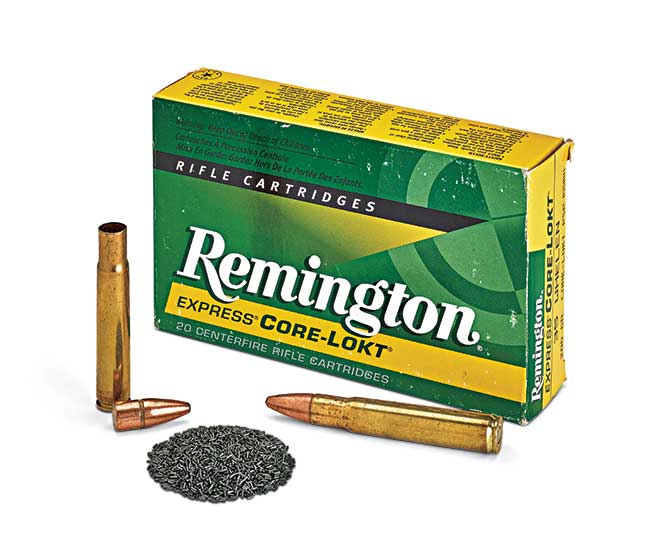
Remington Express Core-Lokt .35 Whelen, 200 gr.
Remington continues to offer two .35 Whelen loads: 200-grain Core-Lokt and 250-grain softnose, the latter a Hornady bullet. Federal Premium loaded with the 225-grain Trophy Bonded Bear Claw is a good choice when sticking with one load for everything from mice to moose. Nosler ammunition loaded with 225- and 250-grain Partition bullets has a following, and Winchester loads the cartridge as well.
Hornady Superformance with a 200-grain softpoint is the fastest factory load available. I wondered whether the 2,920-fps velocity printed on its box was a misprint, but skepticism turned to amazement when my Oehler Model 33 indicated an average of 2,962 fps from the 22-inch barrel of my Mauser. That’s more than 100 fps faster than maximum handloads with 180-grain bullets in that rifle. It should be devastating on deer. A second load with the 225-grain GMX at 2,800 fps or so would be equally effective on elk and other large game.
I have also owned a couple of Model 700s in this caliber, but my favorite is a custom rifle built about 25 years ago by Butch Searcy, who is now better known for building fine double rifles. He began the project by installing one of Sam May’s Apex barrels on a Whitworth ’98 Mauser square-bridge action.
The barrel is 22 inches long, and since the Barnes 275- and 300-grain bullets were available back then, I specified a rifling twist rate of 1:12 inches. Butch also machined a quarter rib for the barrel, installed a banded ramp sight up front and modified the bolt shroud for a Model 70-style safety.
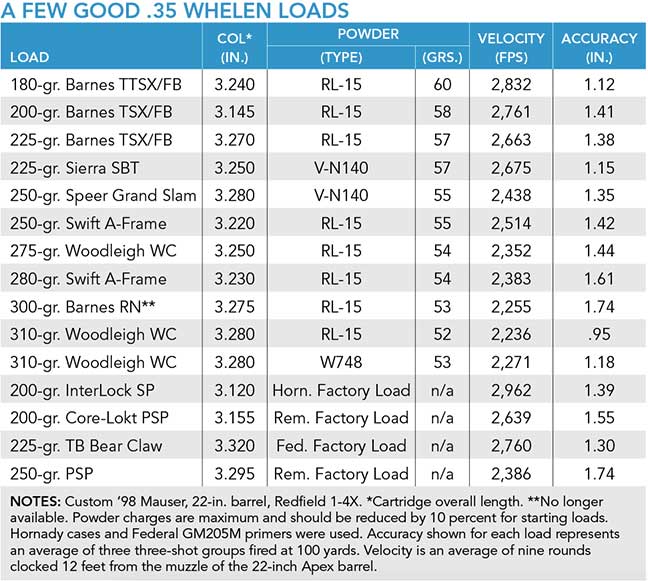
The barreled action was stocked by E.C. Bishop & Son custom shop in Warsaw, Missouri. The only scope it has ever worn is a Redfield 1-4X variable from the 1960s. It is held in place by quick-detach rings available at the time from Kimber of Oregon. Weight with scope is 8½ pounds. It is the most consistently accurate rifle in .35 Whelen I have ever owned and quite comfortable to shoot.
Down through the decades, a number of .35-caliber cartridges have been introduced, but not a single one has managed to win the hearts of America’s hunters. They range from oldies such as the .35 Remington, .35 Winchester, .35 Whelen, .35 Newton and .350 Griffin & Howe Magnum to newer numbers such as the .358 Winchester, .356 Winchester, .350 Remington Magnum and .358 Norma Magnum.
The .35 Remington was once quite popular among hunters in the east. It is the chambering I chose for my very first store-bought deer rifle and was used to take my first black bear. Sad to say, very few Marlin 336s in that caliber are sold these days.
The .35 Whelen has yet to win a popularity contest among hunters and probably never will, but the fact that it has been in use for more than 90 years is proof of its ability to shrug off the challenges of more modern cartridges. It may eventually be the only cartridge of its caliber we have left.
Read more: http://www.gunsandammo.com/ammo/rifle-ammo/the-35-whelen-story/#ixzz5G4OiyUWt














